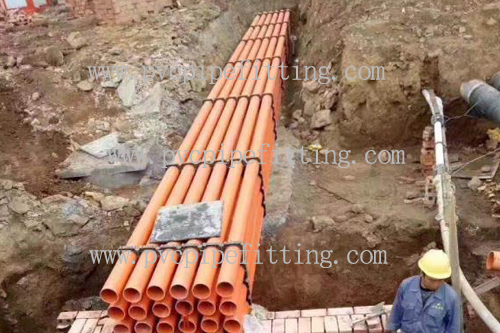In the CPVC fire sprinkler systems, how to cut the CPVC fire sprinkler pipeline properly?
In the CPVC fire sprinkler systems, how to cut the CPVC fire sprinkler pipeline properly, I hope it can help you!
One of the advantages of CPVC fire sprinkler systems is its simple cutting and jointing process. With some simple steps, the installation personnel can cut the CPVC fire sprinkler pipe to the required length in just a few minutes, and ensure that the cutting edge of each cutting is clean and tidy.
In order to ensure the personal safety of the installation personnel, the installation personnel shall wear protective gloves and goggles during installation, and consult the manufacturer’s safety installation guide.
CPVC cutting tool
The CPVC fire sprinkler pipe can be easily cut with simple manual tools, without power or heat.
In order to get the best result: gear tool or fine tooth saw is recommended for CPVC fire sprinkler systems. If using a fine tooth saw, make sure that the blade has 16-18 teeth (6-7 teeth / cm) per inch, with a maximum error of 0.025 inch (0.064 cm).
When cutting CPVC fire sprinkler pipes, it is necessary to ensure the maximum surface area during chemical cold fusion welding. CPVC fire sprinkler systems strongly recommends the use of miter sawboxes and other guiding devices to ensure vertical cutting.
A ratchet with a sharp blade can also be used by the installer when the temperature is above 50 ° f (10 ° C). If the blade is not sharp enough or the temperature is low, the fitting will be compressed and damaged. A circular saw can also be used. Make sure the speed is up to 6000 rpm. You can also choose a band saw with a speed of 3600 ft / min (1097 M / min).
Broken pipe treatment
It is necessary to check whether the pipe fittings are broken or damaged before and after cutting the CPVC fire pipe. If damage or fracture is found at the end of the pipe fitting, the installer shall cut at least two inches (5.08cm) from the end of the obvious fracture.
Handling clean edges
After vertical cutting and cleaning, remove all burrs or filings and chamfer the inside and outside of the pipe. If there are fragments, it will make the fitting and the connector not properly jointed, which will eventually lead to insufficient fastening of the joint, or even cause the interruption of water flow.
Slight chamfering at the end of the pipe facilitates deeper insertion of the base of the pipe fitting, which helps to distribute the cold melt evenly at the joint. When removing burrs and filings, you can use a small fold or file, but it is best to use a chamfering tool for chamfering.
One of the advantages of CPVC fire sprinkler systems is its simple cutting and jointing process. With some simple steps, the installation personnel can cut the CPVC fire sprinkler pipe to the required length in just a few minutes, and ensure that the cutting edge of each cutting is clean and tidy.
In order to ensure the personal safety of the installation personnel, the installation personnel shall wear protective gloves and goggles during installation, and consult the manufacturer’s safety installation guide.
CPVC cutting tool
The CPVC fire sprinkler pipe can be easily cut with simple manual tools, without power or heat.
In order to get the best result: gear tool or fine tooth saw is recommended for CPVC fire sprinkler systems. If using a fine tooth saw, make sure that the blade has 16-18 teeth (6-7 teeth / cm) per inch, with a maximum error of 0.025 inch (0.064 cm).
When cutting CPVC fire sprinkler pipes, it is necessary to ensure the maximum surface area during chemical cold fusion welding. CPVC fire sprinkler systems strongly recommends the use of miter sawboxes and other guiding devices to ensure vertical cutting.
A ratchet with a sharp blade can also be used by the installer when the temperature is above 50 ° f (10 ° C). If the blade is not sharp enough or the temperature is low, the fitting will be compressed and damaged. A circular saw can also be used. Make sure the speed is up to 6000 rpm. You can also choose a band saw with a speed of 3600 ft / min (1097 M / min).
Broken pipe treatment
It is necessary to check whether the pipe fittings are broken or damaged before and after cutting the CPVC fire pipe. If damage or fracture is found at the end of the pipe fitting, the installer shall cut at least two inches (5.08cm) from the end of the obvious fracture.
Handling clean edges
After vertical cutting and cleaning, remove all burrs or filings and chamfer the inside and outside of the pipe. If there are fragments, it will make the fitting and the connector not properly jointed, which will eventually lead to insufficient fastening of the joint, or even cause the interruption of water flow.
Slight chamfering at the end of the pipe facilitates deeper insertion of the base of the pipe fitting, which helps to distribute the cold melt evenly at the joint. When removing burrs and filings, you can use a small fold or file, but it is best to use a chamfering tool for chamfering.
Shijiazhuang xingyin import and export trade Co., Ltd. has studied CPVC fire sprinkler systems for many years in china, with guaranteed product quality. we are CPVC fire sprinkler systems Manufacturer,and CPVC fire sprinkler systems supplier,CPVC fire sprinkler fitting Manufacturer,cpvc fire sprinkler pipe Manufacturer,cpvc fire sprinkler fitting supplier,cpvc fire sprinkler pipe supplier,Our CPVC fire sprinkler pipes and fittings have been exported all over the world.
CPVC fire sprinkler systems products web:https://www.pvcpipefitting.com/product-category/cpvc-fire-sprinkler-fitting/

没有评论:
发表评论